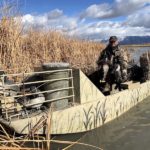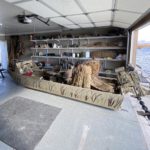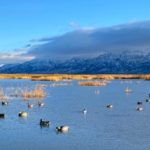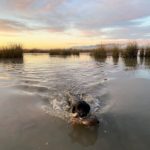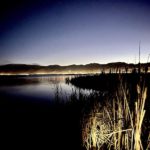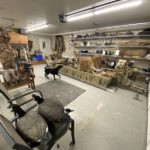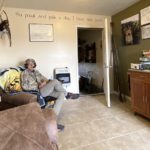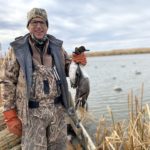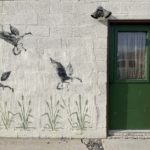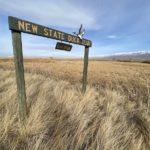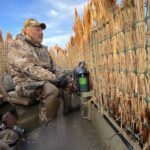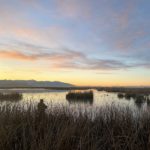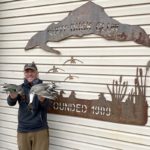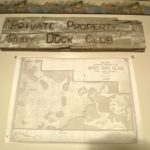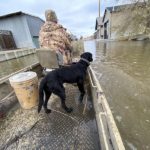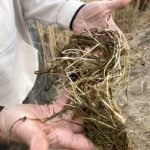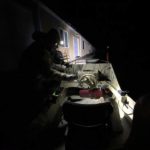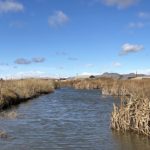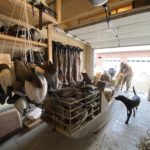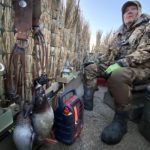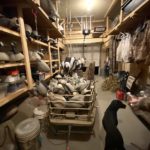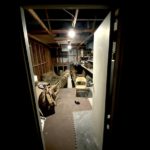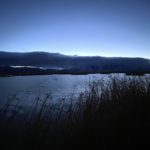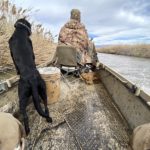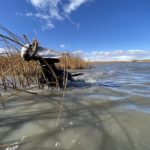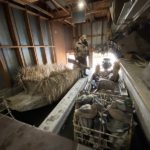Following a beautiful morning of Utah duck hunting on the south end of Utah’s Great Salt Lake, local historian Jack Ray describes to Ramsey Russell the history of the Rudy Duck Club and other venerable duck hunting camps in Utah’s Great Salt Lake basin. The sign above them reads, “So fowl and fair a day I have not seen.” Why were so many great duck camps established way back when and why do they still exist? Located in one of the driest states in the US, how are many of these properties managed and, importantly, what would likely happen if they ceased to exist? What’s so special about the boats used and how do camp amenities reflect the boats importance to hunting this these type properties? This interesting episode concludes the Utah duck hunting portion of Ramsey’s 2020 North American Waterfowl Tour.
The Rudy Duck Club, Other Utah Duck Hunting Clubs and the Relevance of Utah Duck Clubs to Waterfowl Habitat Conservation
Utah Duck Hunting
Ramsey Russell: Welcome back to Duck Season Somewhere. It’s a sad day. I’m on my last day in Utah and as you all well know, I’ve been here a good long spell. It may be one of my absolute most favorite places to hunt in North America. Don’t ask me why. I’ve hunted public, I’ve hunted private, I’ve hunted some long standing historical clubs, I’ve hunted some new clubs, a whole variety of species: puddle ducks, teal, pintail, canvasbacks, bluebill, tundra swans, Canada geese. The diversity is astounding, the kind of habitats they’ve got here is astounding. I was telling somebody this morning, I’ve not been to the boat ramp public one morning, not one morning in two years that I’ve hunted in Utah and met an unfriendly person. That’s crazy though. Coming from the Deep South, that’s a little different. But anyway, this morning’s my last morning. I’m on the south end of the Great Salt Lakes with today’s guest, Mr. Jack Ray. We’re hunting ducks in Utah at the Rudy Duck Club, which he’s going to tell us all about and some other stuff. Jack, how are you today?
Jack Ray: I’m doing fine. It’s a great day to be out here and great day to be looking at the marsh.
Ramsey Russell: Do you ever feel yourself taking your surroundings out there in the duck call for granted?
Jack Ray: No, I never do. I never get tired of sunrise or sunset or any time out in the marsh and seeing all of the wildlife, all of the waterfowl and everything else that’s out there. It always amazes me.
Ramsey Russell: As a native Mississippian and coming out to this part of the world with the mountains in the morning, it’s astounding. It’s unbelievable to me every time the sun rises in the state of Utah that I’m hunting, whether it’s inches deep water or feet deep water, a small pothole like we hunted a day or a wide open spanse, it takes my breath every time. This morning as the sun was coming up, looking back at the Wasatch Mountains, they were purple with what looked like somebody had drug finger paint white down the snow streaks. You see the city of Bountiful, and all these little towns. When you can see them in the morning, the Mormon Tabernacle burned most brightly like a Christmas tree light. There’s ducks over overhead. It’s just spectacular.
Jack Ray: Yeah, it is and it’s really awe inspiring. Candidly, I wish more people in Utah had the experience to stand out in the marsh and to see that and to gain an appreciation of it.
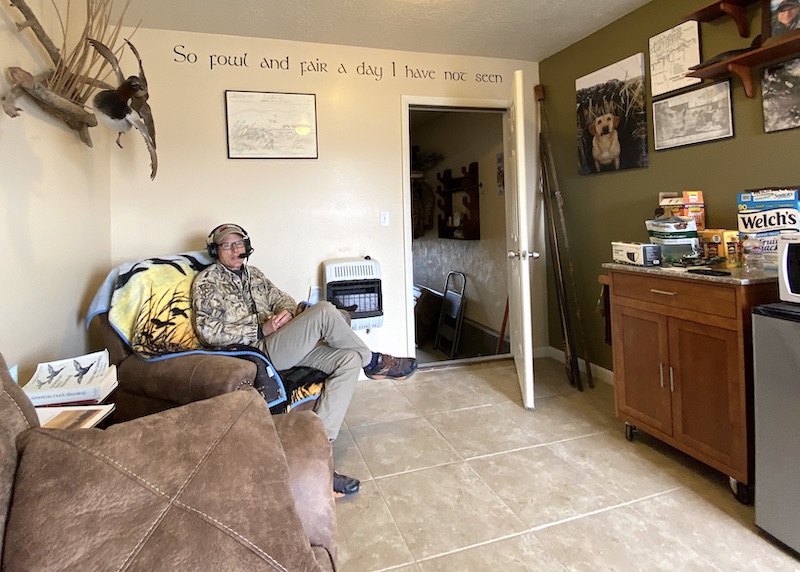
The Rudy Duck Club
The first duck hunting clubs in Utah were in the 1890s and that’s a little later than some of the earliest duck clubs in some other parts of the country, but still early. This club was founded in 1909.
Ramsey Russell: It’s astounding. It is absolutely unbelievable. Where to start this morning? I want to start with the name of your Utah duck hunting club, Rudy Duck Club, because all week long people said, “Well, when do you leave, when are you going home,” and I said, “Well, I’m going to stay around till then and I’m a hunt with Jack out the Rudy Duck Club.” “Oh yeah, yeah, yeah. The Ruddy Duck, the Ruddy Duck.” That’s what everybody called it. It was the Ruddy Duck. What’s the origin? Is it named for the Ruddy Duck?
Jack Ray: No. Before I became a member of the club, I had the same problem. I thought it was the Ruddy Duck Club and they just didn’t know how to spell Ruddy. But then I learned doing some historical research that actually it is named after the man who owned the land out here originally. He was one of the early settlers in this part of Salt Lake County and his name was Frank Rudy, so they just named the duck club after him. That was the custom with some of the Utah duck hunting clubs back in that era, they just named them after the person who originally owned land or the person who originally founded the club. There’s a Burnham Duck Club named after the Burnhams who first owned the land. There was a Halloran Duck Club named after that person and the Harrison Duck Club. It’s just kind of a custom in this area that a lot of the clubs followed.
Ramsey Russell: What is the history of this Utah duck hunting club? I know it’s been around quite a while.
Jack Ray: Yeah, it has been. In a lot of these areas, there were a lot of wetlands on the south end and all around the eastern shore and northern shore of the Great Salt Lake back in the 1800s and early 1900s. As interest in duck hunting increased and increased until Utah duck hunting really hit a fever pitch in the late 1800’s and early 1900’s, people started acquiring land for duck clubs. The first duck clubs in Utah were in the 1890s and that’s a little later than some of the earliest duck clubs in some other parts of the country, but still early. This club was founded in 1909. There was a precursor club in 1907 called the Rudy Slew Duck Club, but this duck club was founded in 1909 and it has continued in existence since that time, essentially unchanged. In fact, I’ve got a map on the wall that dates from 1920 and it shows the duck club and the Big Lake and all of the islands. Everything has pretty much changed since that time. Even though we’re on the doorstep of Salt Lake City, we have managed to preserve this in its natural state for over 110 years now.
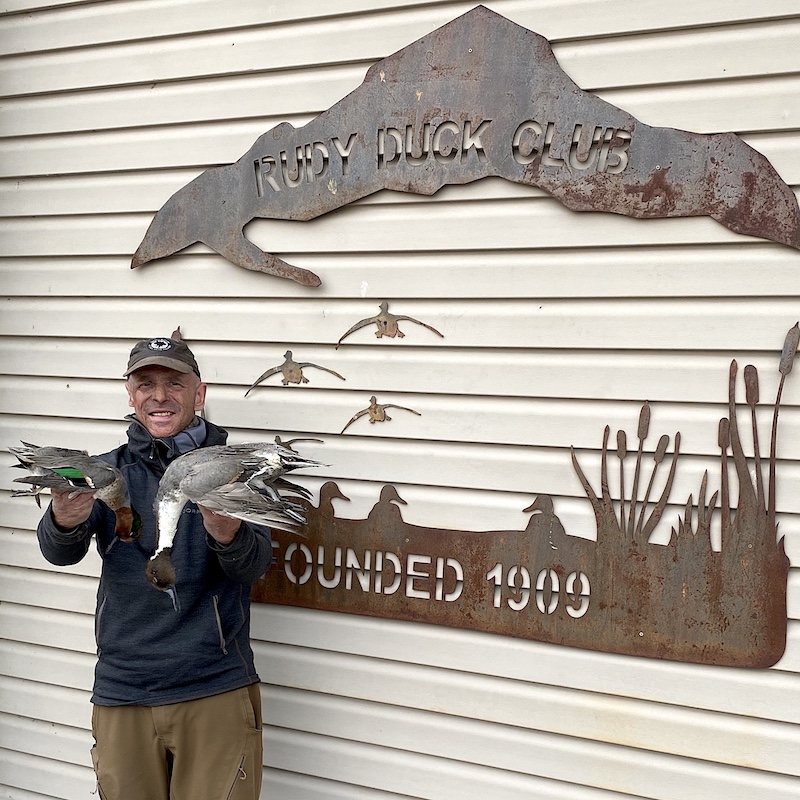
Specialized Utah Duck Huntig Club Boats
Jess Johnson started building these boats and designed them because of his familiarity with how the clubs worked back in the 1960s. He has been building them ever since. They’re very narrow boats. The steering is up at the front with the motor in the back…and they’re designed to navigate the narrow channels and the even narrower water control structures that go in and out of these different impoundments.
Ramsey Russell: One of the most distinctly Utah duck hunting experiences I’ve seen since being here this week is hunting at some of these clubs, these old historical clubs, back in the 1900’s – 1800’s. We pulled up to your camp today. GPS took me 12 miles southwest. I was over in the hood when I called you earlier this morning, drove like a banshee Indian to get here. But it did.
We pulled into this camp. Nice, neat, organized, tidy. You’ve got prefab metal buildings. You open up the door and it opens into this little mud room, a nice mud room with a couch and a chair and taxidermy and maps. You go right into a dry boat slip. I’ve seen that at the Chesapeake Club with a dry boat slip, at the new State Club, they had a wet slip, but it’s unbelievable. It’s behind door one, it’s a duck blind. You climb into these little boats, these custom built little Utah duck club boats. I’ve seen them at all three camps. Everybody seems to use them and going into the marshes is convenient. Even the blind design is perfect for y’all’s situation. What are the origins of that boat? Who made them? How did it come to be? How did it come to be so prevalent in these camps out here?
Jack Ray: We live in a desert out here. There is a great competition for water. The clubs were interested in shepherding their water to the best of their ability. Channels were built to different impoundments in order to maximize the amount of habitat on the acreage that the club owned and as the land gradually descends towards the Great Salt Lake, it’s gradually going downhill. In order to maintain impoundments at certain levels, they have to have water control structures between the different impoundments and on the channels. They needed to have a boat that was narrow enough to navigate those water control structures and go up and down these water control structures.
There is a gentleman who lives in Farmington, which is just north of Bountiful close by here. He was born and raised on a duck club here on the south shore of the Great Salt Lake. His name is Jess Johnson and he started building these boats and designed them because of his familiarity with how the clubs worked back in the 1960s. He has been building them, if you can believe it, ever since. They’re very narrow boats. The steering is up at the front with the motor in the back. Unlike a lot of duck boats, where you steer the boat from the back of the boat, these you actually steer from the front of the boat and they’re designed to navigate the narrow channels and the even narrower water control structures that go in and out of these different impoundments.
Ramsey Russell: It’s an all-weld, no rivets. I would say your boat is 14 or 15 foot long?
Jack Ray: Yeah, my boat is 14 ft. long. When they originally started building the boats, they were about 11.5 ft., I think. They were a little smaller back then and they had smaller short shaft outboard motors. Jess Johnson was a master aluminum welder. His father used to build duck boats and he built them back when they built them out of steel and wood and canvas and different things, but those would break down over time. I think Jess’s desire was to build something that was more functional, more durable, and could also be used as a stable shooting platform so that people could shoot out of it.
Ramsey Russell: It’s amazing. But some of the features he’s built into it over the years, like I was told there’s some real nice runners underneath, is because y’all do have to bust ice up here at times. In the bow of the boat, there’s a basket that’s removable, you put your decoys in it. I’ve seen basket fabrications or separators in the back and then the blinds I’ve seen have these mats rolled up with little poles on them and you unwind it and you stick it in the sides. Imagine as you pull into the cattails, which are marsh brown grass, and you’ve got a nice stable bottom to stand up on and a saw-well boat, 40 inches wide maybe, then you put this grass component, it takes five minutes to stick it up. We left a slot open today for Char to work in and out of. She could mark perfectly out of this thing and it was just as stable and comfortable and easy to get around with as any boat I’ve ever ridden in, but it probably wouldn’t work around the country and other situations. It’s crafted and built for this hunting area, isn’t it?
Jack Ray: Yeah, it’s really designed for smaller, shallower bodies of water. If you were to take this out on a body of water with big waves or anything like that, it would be pretty dangerous, I would think. But it’s designed to work on these privately managed wetland areas and it does the job really well.
Ramsey Russell: It does. It’s very convenient hunting to walk in, suit up, step into your boat, roll up the garage door, ease it down into the water, crank it up, motor off and come back, put it right up into the rollers, wench it back up, un-suit, and now record a podcast. It’s as easy and convenient of hunting as I’ve ever seen, absolutely first class.
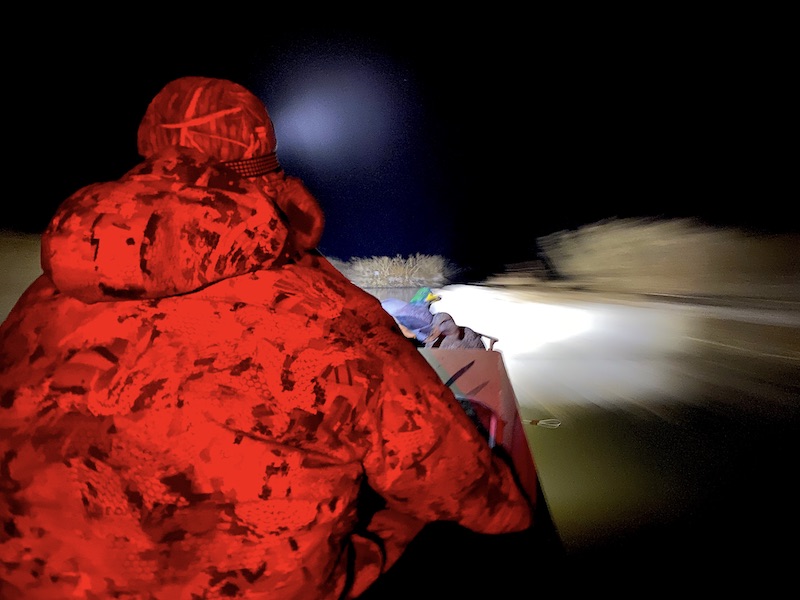
Ramsey Russell: I sure enjoyed this morning. We did see some bird activity, but in the last week I’ve been here in Utah duck hunting, it seems to be that a lot of birds are transitioning between new birds coming in, old birds leaving out. The birds that are sitting here seem to be a little PhD’d up a little bit. Those pintails sure gave it up this morning though, didn’t they?
Jack Ray: Yeah, the pintails floated right in, but the other ducks were not giving us a lot of love this morning. They stayed out at a distance and I think they’ve been around the block here for a few weeks and probably know the drill.
Ramsey Russell: You had a word for it this morning, the November lull, the November doldrums.
Jack Ray: Yeah, we get that here. October is usually very good. Then when you get into November, the ducks come through in pulses or waves and come and go. I think we’re in between a couple of those pulses right now.
Utah Duck Hunting Club Old-timer Stories
Ramsey Russell: You told me a pretty interesting story this morning. You met somebody that had been duck hunting in Utah here a long time: an old timer, so to speak. We talked about decoys and a long-tail motor and I was particularly interested in the story about the tall pintails. Can you share some of those stories?
Jack Ray: He’s somebody who would invite me to hunt out at the club he belonged to. Every year or two I’d go out with him. He hunted literally six days a week for probably for decades. He knew the marsh like the back of his hand and he knew where the ducks were going to be. But in any event, he told me a story, going back to when he was a much younger hunter and he had shot at some drake pintails flying way overhead, maybe stretching his barrel a little too far for the shot that was available. A lot of the marsh was covered in snow and there was some upland area behind him, covered in snow. He had a reason to go back there a little later. The path that these ducks had taken after he shot at them, apparently with no effect, he said “they didn’t flinch, they didn’t move.” In the path they took, he saw some drops of blood on the snow. The way he interpreted that was that he believed he had hit those ducks and that because of their height, he just hadn’t gotten the penetration. He needed to bring them down. Ever since then he tried to remind himself to just shoot within the limits of his shotgun and his ammunition and respect the birds.
Ramsey Russell: That’s a lesson we could all be reminded of from time to time, no doubt about it. Did you tell me that was the same hunter that had, as a child, worked at some of these clubs and picked up some of the old wooden decoys that had been cast off? Was that the same person?
Jack Ray: No, that was somebody different. His parents were the caretakers of a club out here probably in the 50s and 60s, when lighter mass-produced decoys were coming online: the paper maches, the plastics, those kinds of things. The members of the duck club would just be pitching out their old wooden decoys. As a young boy, he thought it was awfully neat to gather these decoys up and collect them and he just kept piles of them in his house and they were mostly very beat up, very much the worse for wear. Shot up and paint rubbed off and everything else. He had hundreds of these wooden decoys that he just gathered up and some made out of canvas and some made out of Styrofoam and just about every different type of decoy making technology that came along.
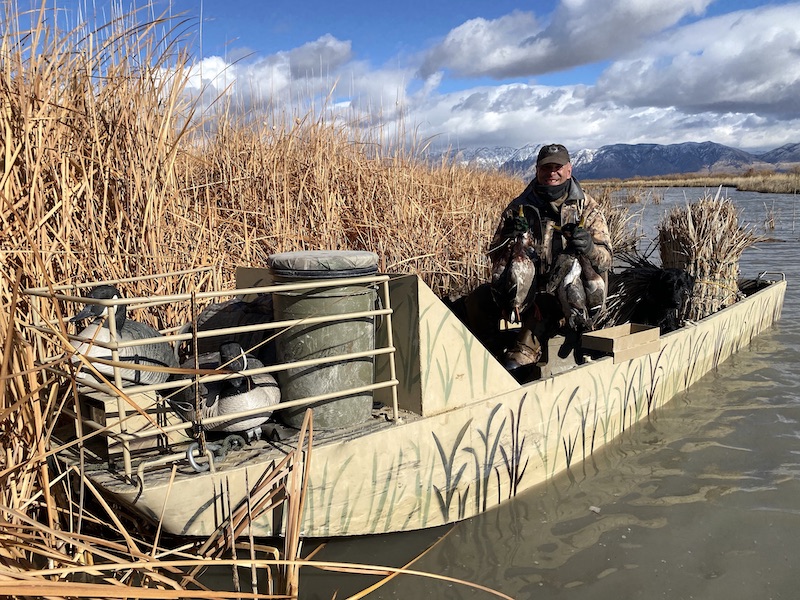
The Role of Utah Duck Hunting Clubs in Waterfowl and Habitat Conservation
Private landowners and club hunters that provide so much time and so much money towards quality habitat really do benefit society. They benefit the hunters in the general area. They benefit the bird watchers by providing wintering habitat for waterfowl.
By acquiring these lands and associated water rights back in the early 1900s, Utah duck hunting clubs preserved an entire ecosystem. If it hadn’t been for these duck clubs acquiring the land and securing water rights, the vast majority of it would have been lost, not just because of the land the club’s preserved, but it also then provided an incentive for the state to go out and then acquire and develop areas for the public hunters.
Ramsey Russell: We talked a lot this morning. We had a lot of time to visit in between volleys and watching birds. As I described to you, we hunters champion ourselves as conservationists and the role of duck hunting clubs in conservation really stood out strong to me last year when I had come to properties like this and I see the passion and the commitment of club owners to providing quality habitat and providing sanctuary and providing quality shooting and all that good stuff. It made me think as I looked at some of these properties, at some very iconic Utah duck hunting clubs such as this one. It made me realize that there are some people that resent us club owners for having a private club to hunt instead of public, but the ducks don’t just come here and sit to get killed. They fly around.
The thing I marvel about in the state of Utah, there’s a lot of these old private clubs that are enhancing their waterfowl habitat that are providing sanctuary. Besides that, there are state and federal properties that have a tremendous amount of spatial, inviolate sanctuary to hold birds. Everywhere I’ve looked, everywhere I’ve been, on state, on federal, on private, on this club, on that club, either they’ve got a spatial sanctuary or they’ve got a temporal sanctuary. Or both. There’s sanctuary everywhere. It made me realize that private landowners and hunters that provide so much time and so much money towards quality habitat really do benefit society. They benefit the hunters in the general area. They benefit the bird watchers by providing wintering habitat for waterfowl. Do you believe that to be true? Do you see examples of that here in Utah?
Jack Ray: Yeah. It’s interesting when you look back on the history and maybe to put it in context, you need to understand that probably 80% of the population of Utah is clustered around the eastern and southern shores of the Great Salt Lake. There’s tremendous competition for land and there’s tremendous competition for water. We live in a desert. Back in the late 1800s and early 1900s, people started acquiring these lands for the purpose of preserving them as wildlife habitat. Now, obviously, the incentive was recreational. They wanted to come out and have a place to escape city life and shoot some ducks. But the upshot of that was that by acquiring these, they preserved them.
You only have to look on the other side of the fence of most of these duck clubs and realize that on the duck club side of the fence there’s vibrant habitat for all kinds of species of shorebirds and waterfowl and everything else, and on the non-duck club side of the fence, there is nothing in terms of wildlife. It’s either been leveled and drained, it’s been built on its light industrial, there’s an airport to the south of us, there’s different kinds of housing developments. By acquiring these lands and associated water rights back in the early 1900s, they preserved an entire ecosystem.
The Great Salt Lake really is a feature that has a very outsized influence given its size on the hemispheric bird populations. Birds come here from the arctic and they go all the way to Argentina, different species of birds, and they absolutely depend on the Great Salt Lake. If it hadn’t been for these clubs acquiring the land and securing water rights, the vast majority of it would have been lost, not just because of the land the club’s preserved, but it also then provided an incentive for the state to go out and then acquire and develop areas for the public hunters. All of the public WMAs, which amount to something like 100,000 acres along the shore of the Great Salt Lake, which are open to the public for waterfowl hunting seven days a week, no reservation required, were acquired and developed specifically to provide recreational waterfowl experiences for the common public.
Most of the Utah duck hunting clubs that were established along the shore of the lake back in the late 1800s and early 1900s, were not high-dollar duck clubs. That continues to this day. There may be a couple of clubs that cater to the upper echelon of society, but most of the rest of us are in clubs that very much cover the average spectrum of socioeconomic status in society. They reflect where we live and so they are for everybody. It’s a different kind of experience. Some people prize the duck club experience and some people prize the freedom to roam and go wherever they want on the public marshes. All of that is really derivative of the huge interest in waterfowling over a 100 years ago.
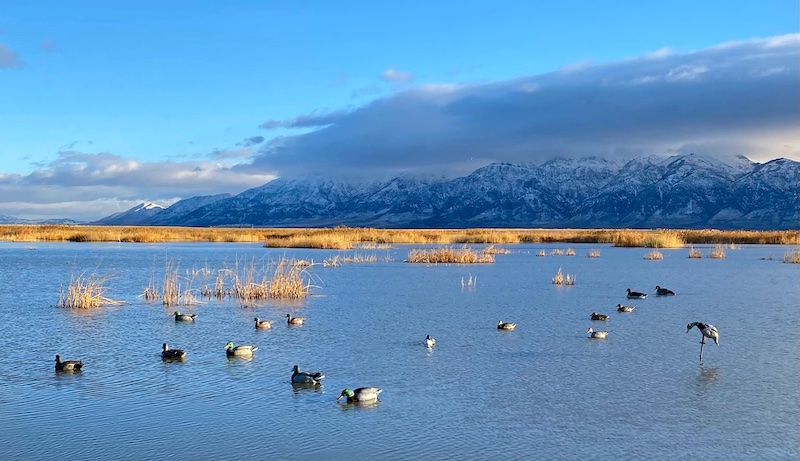
Ramsey Russell: When you take the state and the federal and the private, it really makes this place special in terms of habitat. I’m just going to reiterate what you said about the recreational interest in sport hunting of ducks. Some people bought land and it is now protected as waterfowl habitat in perpetuity. Can you speak to your involvement in ensuring that a lot of these lands through here will not become Salt Lake City subdivisions?
It’s no longer theoretical for them. It becomes real and it becomes something that’s felt by them and that makes all the difference.
Jack Ray: We’ve tried really hard to make people aware of exactly what’s out here. Every year I take out government officials, elected representatives, and take them on a boat ride out in the marsh. They get to see the cattails blowing in the breeze. They get to see blue herons flying by the boat and the snowy egrets and flocks of waterfowl coming up off the marsh. It’s a spectacle of nature, a jaw-dropping experience for them. I think in some sense it’s transformative, because the large majority of them come back from that experience and they say, “You know, these are people who are in a position to make a difference.” They say, “I had no idea what was out here, what can we do to save it? What can we do as a government to make sure that these natural resources and that this heritage, because it is a heritage out here of over a century, what can we do to make sure that this heritage is preserved?” They’re much more amenable. It doesn’t mean that they’re going to do things that are crazy, but it does mean that they’re going to be open and receptive to ideas and to policies and statutes that are going to help preserve these areas in these habitats in perpetuity.
Ramsey Russell: They get to see it and maybe form a personal connection with the resources rather than something out of the car windshield on a pamphlet and maybe they just get a little more vested interest to personally protect it. Maybe they can see the intrinsic value of this resource out here. I think it’s brilliant.
Jack Ray: It’s no longer theoretical for them. It becomes real and it becomes something that’s felt by them and that makes all the difference.
Waterfowl Habitat Conservation Issues in Utah
The Great Salt Lake is already thirsty, it’s diminished in size quite a bit from where it was at its peak about 35 years ago.
Ramsey Russell: What are some of the issues y’all wrestle with out here in this region? I know that water is a real big deal in this part of the world. I hear a lot of stories as I’m hunting with different folks: everybody wants the water, the city wants the water, the government wants the water, the refuge wants the water, the state wants the water, the private clubs want the water. How does all that work? What are the battle lines and water rights? Because that’s a foreign concept to Mississippi.
Jack Ray: Water rights are everything in the west, particularly in the arid portions of the west and Utah is the second driest state in the nation. Ever since settlers arrived here in the 1800s, there’s been tremendous competition for the water resources that are available and that continues to this day. We’ve got a burgeoning population. We continue to have agriculture that uses a lot of water to continue their activities which are appropriate. As all of these demands keep continuing to grow and to escalate, the pressures on the use of water continue to grow. There is pressure to divert more of the water that would otherwise go into the Great Salt Lake for use along the Wasatch Front for municipal and industrial use. There is pressure to potentially reuse water that would otherwise go through treatment plants and then flow out into the Great Salt Lake instead to send that back uphill and put it on golf courses or something like that. There are all these ongoing pressures to diminish the flow into the Great Salt Lake.
The Great Salt Lake is already thirsty, it’s diminished in size quite a bit from where it was at its peak about 35 years ago. Creative solutions have to be found and I’m really happy to actually say that there are some positive developments in that regard. They’re developing changes in state water policy and the way water is managed to allow more flexibility of water rights owners to allow their water to be used for conservation purposes at times. The concept of water banking is one that was recently established in the state of Utah. There are a lot of people who are thinking about this and it isn’t just duck hunters who are interested in a vibrant Great Salt Lake. There are industries that depend on the Great Salt Lake being there, whether it’s the brine shrimp industry or certain mineral extraction industries, like the salt industry. There are a lot of conservation and environmental groups who are also interested. What’s been happening over the last few years is a lot of these different organizations, private and public and governmental entities are coming together to try to find creative solutions to allow more water to make its way down through the Great Salt Lake ecosystem and into the Great Salt Lake.
Waterfowl Habitat Management on Utah Duck Clubs
Ramsey Russell: That’s great. Jack, what is this property we hunted today, what does it look like during the summertime? Is the water level the same? What does a typical water fluctuation on a duck club like this look like throughout the year?
Jack Ray: Starting in January, we still have a lot of water, although it’s iced up at that point in time, frozen over, and then as the waterfowl season ends around the first of February, the club is drained and that allows us to help manage some of the vegetation that would otherwise consume the marsh, particularly some of the invasive vegetation like Phragmites.
Ramsey Russell: When you say drained, is it ever dry where you could drive an ATV out over where we were hunting today? Or is it just mucky and most of the surface water is gone?
Jack Ray: The surface water is gone, but it’s still really wet and muddy. It allows us to do maintenance on dikes and dredge channels and do different things like that. It stays in that state for probably about one or two months. It also allows the soil to oxygenate and to take up some nutrients. That also helps with some of the pond weed growth and other things once we flood up and then the club will be flooded up probably around March or early April. That’s when we really get a push of nesting activity. We have a lot of nesting gadwalls, nesting cinnamon teal, tons of nesting shorebirds as well as eared grebes and all kinds of different birds. It’s really amazing.
We have some islands out on our main lake and those islands will just be covered with bird nests because they’re comparatively protected from predators. We really have an abundance of nesting birds out here and that will continue on through the summer. Sometimes we get a little too much in the nutrient department out on the club. We get a lot of nitrogen and things coming down from the treated water. We got some algae blooms and that can impact the growth of our sago pondweed.
Ramsey Russell: That’s what you’re trying to grow, sago pondweed?
Jack Ray: Yeah. sago pondweed is kind of the bread and butter of most of these marshes on the Great Salt Lake. When you get a really good growth of sago pondweed, it makes the ducks happy and feeds a lot of different birds. The carp can impair that as well. We’re always trying to control the carp and come up with ways to try to manage the carp populations out here, also.
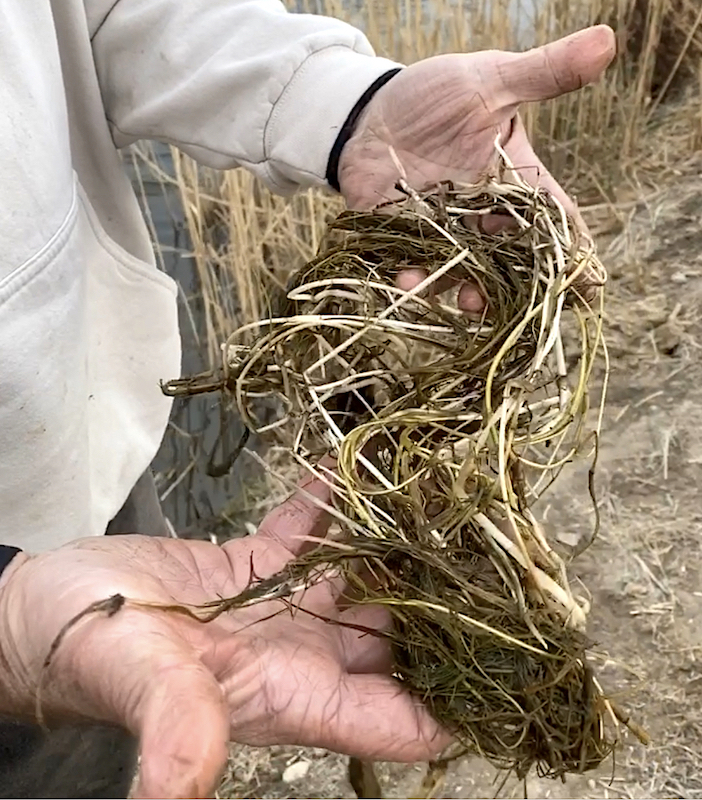
Ramsey Russell: What species of waterfowl do y’all primarily manage for out here? Is it more ducks? What species seem to predominate your bag? Green-winged teal, pintail? We saw a big diversity out there today.
Jack Ray: Yeah, that’s one of the interesting things and I’m sure it’s not unique to the Great Salt Lake, probably a lot of other areas it’s the same, but it’s not at all uncommon. If you’ve got a limit of seven ducks to get, four or five different species of ducks. Numerically , green winged teal make up a good part of the bag. Pin tails are very abundant, but of course the limit on those is low. You can only get one of those a day. We also get a lot of divers through here. Later in the season, we get a lot of canvasbacks and a lot of bluebells as well as buffleheads and redheads and ring-necks and just about everything else.
Ramsey Russell: Canvasbacks excite me. You could tell this morning when that pair of canvasbacks gave us a high look I got excited. I saw that big red head of that canvas flying over the pin tails, they would pop over that levee about 70, 80 yards in front of us and never flap their wings, just slide right into the spread and they put on a show even after we got our respective limits. [We saw] green-winged teal, mallards, we saw scaup, It’s quite a quite a bit of species we saw this morning.
Jack Ray: Yeah, and in October you’ll get a lot of Gadwall.
Why are Utah duck clubs so important for waterfowl habitat?
These marshes are not going to naturally self-perpetuate. There has to be water actively managed to get it on to the duck club and keep the water levels appropriate. If you didn’t have the club, if the club were to shut its doors, those water rights would go away and the club would cease to exist. More importantly, the wetlands associated with it would cease to exist almost overnight.
Ramsey Russell: A lot of Gadwalls. Swans we saw this morning. Everywhere in this part of the world, I see swans. I guess eventually they’ll move on down the flyway. What would happen, to kind of hem this up, if y’all shut the doors and walked away from Rudy Duck Club? What would happen to this resource out here?
Jack Ray: It would disappear almost overnight. The only reason, given how tight water is and everything else these days, these marshes are not going to naturally self-perpetuate. There has to be water actively managed to get it on to the club and keep the water levels appropriate. If you didn’t have the club, if the club were to shut its doors, those water rights would go away and the club would cease to exist. More importantly, the wetlands associated with it would cease to exist almost overnight. This club covers something like, to put it in context that people might be able to understand, 180 city blocks of wetlands [that] would disappear overnight. All of that habitat would go away. Each time you lose a block of waterfowl habitat like that, it makes the adjacent blocks of habitat of other duck clubs that much less productive and that much more vulnerable to development or to the pressures of surrounding human or industrial activities. It impairs the whole ecosystem together, there’s a synergistic effect. But then the reverse of that is you start pulling those building blocks away and pretty soon the whole thing can tumble down.
Ramsey Russell: That’s exactly right. That’s a very good point: nature doesn’t just manage itself, not with this much civilization around. It takes the commitment of hunters to move in and do this kind of stuff. Jack, I just can’t have you on the podcast without here and at least one good Duck Fever story [Read Duck Fever: Hunting Clubs and Preservation of Marshlands on the Great Salt Lake].
“Duck Fever” Story about Chesapeake Bay Duck Club’s Namesake
People wondered why there is a Chesapeake Bay Duck Club in the middle of the Great Salt Lake. The reason for that is that a lot of the big activity out on the Great Salt Lake in the 1800s was market hunting.
Ramsey Russell: Ladies and gentlemen, I was here last year. I came out to Utah to hunt ducks with a friend and just stumbled into something that I had absolutely, positively no idea of, that was the history of this region and the importance of this region to waterfowling and everything else. Jack, have you got a good story? I know I put you on the spot. Have you got a good Utah duck hunting story from Duck Fever, just one of your favorite stories from some of your historical research in this area?
Jack Ray: Yeah. There are a lot of them. One of the things I remember you mentioned is that you hunted on the Chesapeake Duck Club earlier in your trip out here. Originally, it was called the Chesapeake Bay Duck Club. People wondered why there is a Chesapeake Bay Duck Club in the middle of the Great Salt Lake. The reason for that is that a lot of the big activity out on the Great Salt Lake in the 1800s was market hunting. The transcontinental rail line went within just a stone’s throw of the north shore of the Great Salt Lake, which is where the Chesapeake Duck Club is. The market hunters and other hunters who just shot a lot of ducks and wanted to market their excess came to learn that canvasbacks that came from the Chesapeake Bay garnered just fantastic prices whereas canvasbacks from Utah and other locations didn’t get that kind of price. The light bulb went off in somebody’s mind and said, “Well, we’ll just name our area Chesapeake Bay.” Then they could label the boxes of canvasbacks being shipped back east as Chesapeake Bay canvasbacks.
Ramsey Russell: Get that top dollar.
Jack Ray: Get the top dollar, yeah. Sort of a real food, fake food kind of thing.
Ramsey Russell: That’s a very interesting story. When people think of Utah, it’s the second or third driest state in the United States of America. You just don’t think “waterfowl paradise,” great duck hunting at times, but it really was. In my mind, because of that transcontinental railway, because of historical figures like Vince Davis, because of the resource here, what it was then, it marks a very precise point on my timeline of the understanding of things of when recreational hunting began to blossom in America. It’s almost like that exact timeline that they drove that golden spike into the rail. It opened up this paradise and sportsmen came from all over the world to duck hunt here.
Jack Ray: Yeah. Around the very early 1920s, they were debating a bill in Congress to set up what became the precursors, essentially, of the National Wildlife Refuge System. There was testimony before a committee of the House of Representatives. I think it was back in Congress. The person who was the director of what later became the US Fish and Wildlife Service was asked to testify. One of the first projects they wanted to do was out in Bear River Bay. As he was giving testimony, he said, “There are two key critical areas for waterfowl and preserving waterfowl on the North American continent and therefore preserving waterfowl hunting. One of those is the Mississippi Delta and the other one is the Bear River Bay of Great Salt Lake.” So, even back then they understood that the Great Salt Lake was a key linchpin ecosystem for waterfowl in North America and it continues to be to this day and hopefully will be for generations to come.
Ramsey Russell: Yeah, thank you for this morning. Thank you for your time. I really truly enjoyed our duck hunt this morning and I appreciate your time to visit with us today and talk about Utah duck hunting. Folks, I appreciate y’all listening.
There is a tremendous amount of public property out there. I mean [it’s] unbelievable. I haven’t seen the numbers on paper, but I would guess that the amount of sanctuary surface acres of just pure inviolate sanctuary within any given 30 minute or 60 minute drive radius in this area probably exceeds the amount of total surface acres public hunting opportunities in many Deep South states. Utah’s truly an amazing place with friendly people, a lot of species diversity. The next great hunt is closer than you think , it’s just a drive out to Utah, or a short flight. You want to check it out. Put it in your bucket list. Thank you all for listening to this episode of Duck Season Somewhere. I’ll see you from somewhere else next time.




